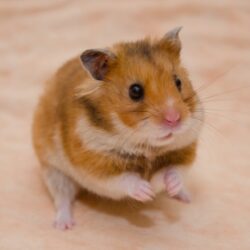Help! My new small furry pet has a pregnancy bump
Bringing a small furry pet into your home is an exciting and rewarding experience. However, if you notice that your new pet has a pregnancy bump, it can be a surprising and concerning discovery.
Vet James Arding at Estcourt Vets advises that whether you adopted a guinea pig, a hamster, a mouse, or another small furry friend, it’s crucial to understand what’s happening and how to handle the situation responsibly. In this article, we’ll explore what to do when your new small furry pet has a pregnancy bump and provide guidance for a smooth and safe journey ahead.
Contact our team for more advice
- Confirm the pregnancy: The first step is to confirm whether your small furry pet is indeed pregnant. Observe any changes in their behaviour and body shape. Look for a noticeable increase in abdominal size. If you have any doubts, contact us to book a check-up with one of our vets. If your guinea pig is pregnant, it is wise to get them checked over as soon as possible as females over six months of age can experience birthing difficulties if this is their first litter.
- Separate the sexes: James wants to stress to new owners that if you have multiple small furry pets, it’s crucial to separate the sexes immediately to prevent further pregnancies. Some small furry species are known for their rapid breeding capabilities, so swift action is essential.
- Provide proper housing: Ensure that your pregnant pet has a suitable and stress-free environment. Provide them with a clean, comfortable, and spacious cage or enclosure with adequate bedding and nesting materials. A quiet and dimly lit area can help reduce stress.
- Offer a balanced diet: Pregnant small furry pets require a well-balanced diet rich in nutrients. Contact our small animal team for dietary recommendations tailored to your pet’s species. Fresh water should always be available.
- Limit stress: James advises that you should minimise handling and disturbances during the pregnancy, as stress can negatively impact the mother and her offspring. Allow her to nest and prepare for the arrival of her babies in peace.
- Prepare for birth: Research the specific needs of your small furry pet species during labour and birth. Different species have different requirements, so ensure you are well-informed about what to expect and how to assist if necessary. Get in touch if you’d like advice on this from our team.
- Seek professional advice: If you are unsure about caring for a pregnant small furry pet or the birthing process, book an appointment with our vets who can provide valuable advice and assistance.
- Finding homes for offspring: Be prepared for the arrival of baby animals. Make arrangements to find responsible and caring homes for the offspring once they are weaned and ready to leave their mother.
Discovering that your new small furry pet is pregnant can be a surprise, but with responsible care and proper guidance, you can ensure the wellbeing of both the mother and her offspring. To summarise the points above, Vet James Arding recommends that you take steps to confirm the pregnancy, provide suitable housing and nutrition, and be prepared for the arrival of baby animals.
Responsible pet ownership extends to all aspects of your small furry pet’s life, including unexpected situations like pregnancy. By taking the right actions, you can ensure a safe and healthy experience for your pet and their babies. We’re here to help – contact our Estcourt Street team for advice.
< Back to articles Estcourt Vets Devizes
Estcourt Vets Devizes